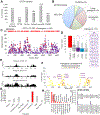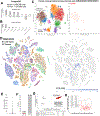Genomic, transcriptomic, and protein landscape profile of CFTR and cystic fibrosis
- PMID: 32734384
- PMCID: PMC7855842
- DOI: 10.1007/s00439-020-02211-w
Genomic, transcriptomic, and protein landscape profile of CFTR and cystic fibrosis
Abstract
Cystic Fibrosis (CF) is caused most often by removal of amino acid 508 (Phe508del, deltaF508) within CFTR, yet dozens of additional CFTR variants are known to give rise to CF and many variants in the genome are known to contribute to CF pathology. To address CFTR coding variants, we developed a sequence-to-structure-to-dynamic matrix for all amino acids of CFTR using 233 vertebrate species, CFTR structure within a lipid membrane, and 20 ns of molecular dynamic simulation to assess known variants from the CFTR1, CFTR2, ClinVar, TOPmed, gnomAD, and COSMIC databases. Surprisingly, we identify 18 variants of uncertain significance within CFTR from diverse populations that are heritable and a likely cause of CF that have been understudied due to nonexistence in Caucasian populations. In addition, 15 sites within the genome are known to modulate CF pathology, where we have identified one genome region (chr11:34754985-34836401) that contributes to CF through modulation of expression of a noncoding RNA in epithelial cells. These 15 sites are just the beginning of understanding comodifiers of CF, where utilization of eQTLs suggests many additional genomics of CFTR expressing cells that can be influenced by genomic background of CFTR variants. This work highlights that many additional insights of CF genetics are needed, particularly as pharmaceutical interventions increase in the coming years.
Conflict of interest statement
Declarations
Conflicts of interest/Competing interests: None of the authors have any conflicts to declare.
Figures





References
MeSH terms
Substances
Grants and funding
LinkOut - more resources
Full Text Sources
Medical
Miscellaneous

